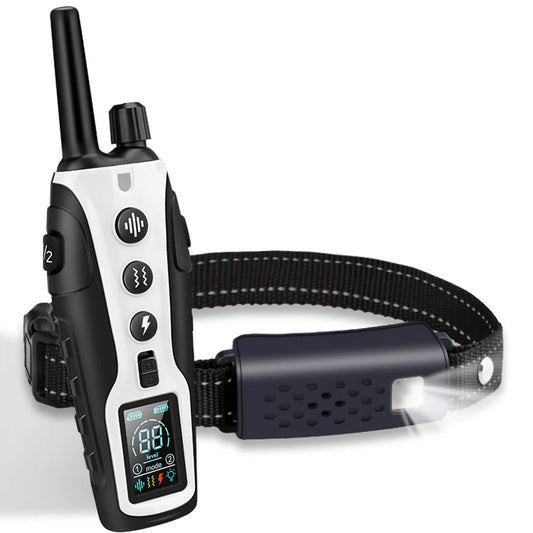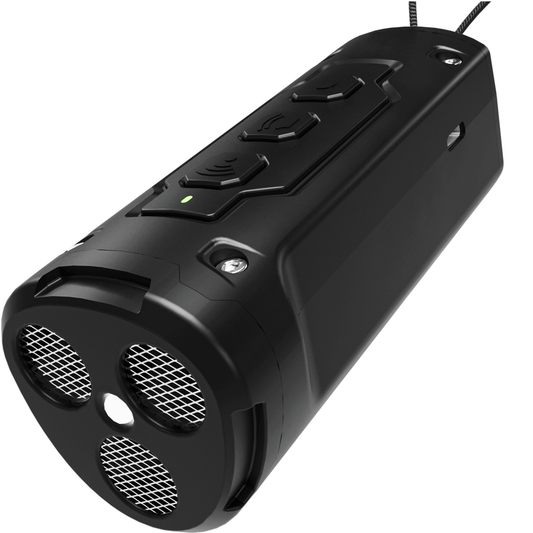How To Stop Dog Barking In Seconds. Barking is a natural behavior for dogs, but excessive barking can be a nuisance for both owners and neighbors. Sound devices have become popular for stopping dogs from barking, but how do they work?
Sound devices that stop dogs from barking emit high-pitched sounds that are unpleasant to dogs.
These sounds are typically inaudible to humans and are often referred to as ultrasonic sounds. When a dog barks, the sound activates the device, and it emits the unpleasant sound, which is intended to stop the barking.
The science behind sound devices lies in the dog's ability to hear high-frequency sounds. Dogs can hear sounds up to 65,000 Hz, while humans can only hear up to 20,000 Hz. The ultrasonic sounds that the devices emit fall within the range that dogs can hear but are often too high for humans to hear.
Sound devices can be effective in stopping barking, but it's important to note that they work best when used as a part of a larger training program. Dogs need to be trained to associate the unpleasant sound with their barking, so they learn to stop barking when the device is activated.
How to Stop Dogs from Barking in Various Situations
To address excessive barking in your dog, it's essential to take proactive steps to prevent it and train your dog about appropriate barking occasions.
Anticipating and preparing ahead is crucial since once a dog starts barking due to excitement or anxiety, stopping them can become challenging. To address the issue of excessive barking in your dog, it is crucial to proactively adopt measures that deter it and educate your dog about suitable circumstances for barking.
Being anticipatory and well-prepared is paramount, as the moment a dog initiates barking due to heightened excitement or anxiousness, reining them in can pose a formidable challenge.
By taking preemptive actions and imparting proper training, you can create a harmonious environment that encourages controlled and well-timed barking.
1. Positive Distraction such as puzzle toys or treats
Implementing positive distractions, such as engaging puzzle toys or tempting treats, can significantly aid in managing excessive barking in your dog. When confronted with triggers that typically lead to barking, redirecting their attention towards these captivating diversions can effectively break the barking cycle.
Puzzle toys challenge your dog mentally, requiring them to solve puzzles to access treats or rewards. This not only keeps them occupied but also redirects their focus away from potential triggers. Similarly, offering delicious treats during situations that might prompt barking can establish a positive association, reinforcing quiet behavior.
It's essential to introduce these distractions proactively and consistently, gradually integrating them into your dog's routine. By doing so, you create a constructive outlet for their energy and curiosity, helping prevent barking out of boredom or anxiety. Remember, successful implementation necessitates patience and persistence as your dog learns to embrace these alternative and rewarding activities instead of excessive barking.
2. Teach the "Quiet" Command
Teach the "Quiet" command to minimize barking. Associate with quietness, reward with treats or praise. Stay consistent, practice in various situations.
Exercise patience, refrain from scolding.
Positive association helps your dog understand "Quiet" leads to positivity, fostering well-behaved conduct and communication.
3. Fence Fighting Barriers. How To Stop Dog Barking In Seconds
Implement obstacles to prevent fence fighting. These barriers deter dogs from engaging in aggressive behavior along fences.
They include solid panels, mesh covers, or planting shrubs for separation. Such measures discourage territorial disputes and enhance a peaceful environment.
Employ effective fence-fighting barriers to thwart confrontations between dogs along property lines.
These barriers serve as a proactive measure against aggressive behaviors, preventing unnecessary stress and conflict.
Options range from solid panels and mesh covers to strategically planted shrubs, all aimed at creating physical separation and reducing visual stimuli that trigger fence fighting. By incorporating these barriers, you create a harmonious living space for both your dog and neighbors, promoting a serene and secure atmosphere.
4. Consult a Certified Dog Trainer
Consulting a professional, such as a certified dog trainer or experienced behaviorist, is highly recommended if your dog's persistent excessive barking remains unresolved.
These experts bring a wealth of knowledge and insight to the table, drawing from their extensive training and practical experience. Reputable trainers in your area, often associated with organizations. can provide valuable guidance.
Their tailored strategies and hands-on approach can help address the underlying causes of your dog's barking, ensuring a comprehensive and effective resolution.
With the guidance of skilled professionals, you can navigate the complexities of canine behavior and create a peaceful, well-adjusted living environment for both you and your beloved pet.
5. Dog Barking Collars
Utilizing humane anti-bark collars is a strategy to discourage excessive barking. These collars emit gentle sounds, vibrations, or mild stimuli in response to barking, prompting the dog to associate barking with these non-harmful cues.
This conditioning process helps the dog understand the need for reduced barking, making it an effective training tool. However, careful selection and supervision are essential to ensure the collar is comfortable and appropriate for your dog's size and temperament.
It's advised to consult a professional before using such collars to ensure proper usage, and to consider them as a part of a comprehensive approach that includes training and understanding your dog's triggers.
6. Dog Training Collars
Utilizing advanced dog collar technology, remote-controlled, humane anti-bark collars provide a solution to excessive barking. These collars emit gentle sounds, vibrations, or mild stimuli in response to barking, with the convenience of remote control.
This approach conditions the dog to associate barking with these harmless cues, promoting reduced barking behavior.
However, careful selection and proper supervision of the collar's usage are essential to ensure comfort and suitability based on your dog's size and temperament.
Seeking professional guidance is advisable before introducing remote-controlled collars, considering them as part of a comprehensive strategy that encompasses training and understanding your dog's triggers.
7. Anti Barking Device
Employing ultrasonic anti barking device offers a contemporary solution to address excessive dog barking. These devices emit high-frequency sound waves in response to barking, which are generally inaudible to humans but discomforting to dogs.
This method conditions the dog to associate barking with this unpleasant stimulus, leading to reduced barking behavior over time. While using ultrasonic devices, it's crucial to ensure proper placement and consider your dog's temperament and sensitivity.
As a component of a comprehensive approach, including training and recognizing your dog's triggers, ultrasonic anti-barking devices can contribute to fostering a quieter and more harmonious environment for both your dog and your surroundings.
8. Ignoring the Barking
Practicing the technique of ignoring incessant barking can play a pivotal role in modifying this behavior. By refraining from providing any attention, such as eye contact or verbal responses, you communicate that barking won't yield a desired outcome.
Dogs often seek interaction and reinforcement, so ignoring their barking removes the reward element. This approach requires consistency and patience, as initially, the dog's barking might escalate.
Over time, as the barking diminishes due to lack of attention, rewarding quiet moments becomes more effective.
Combining this approach with positive reinforcement when the dog remains silent can facilitate the development of desired behavior patterns.
10 Different Dog Barking Types
Gaining insight into the reasons behind dogs' barking is also crucial in curbing incessant barking. Once you comprehend the true intentions behind your dog's barking, you can devise strategies to effectively put a halt to it.
- Alert Barking: A sharp, sudden bark to alert their owner of an unusual sound or presence.
- Playful Barking: A joyful, often high-pitched bark during playtime or social interactions.
- Territorial Barking: A more aggressive and repetitive bark to defend their territory from perceived intruders.
- Anxiety or Distress Barking: A continuous, high-pitched bark due to separation anxiety, fear, or distress.
- Attention-Seeking Barking: A persistent bark to gain their owner's attention or interaction.
- Boredom Barking: Monotonous, repetitive barking when a dog is understimulated or lacks engagement.
- Excitement Barking: A rapid, energetic bark during moments of excitement, like anticipating a walk.
- Compulsive Barking: Repetitive, involuntary barking often seen in dogs with certain compulsive behaviors.
- Social Barking: Barking in response to other dogs or animals as a form of communication or invitation.
- Frustration Barking: A combination of barking and whining due to frustration when unable to access something.
Dog Won’t Stop Barking
If your dog is incessantly barking, it could be indicative of various underlying reasons. Separation anxiety, boredom, attention-seeking, or even health issues might contribute to this behavior. It's essential to identify the root cause to effectively address it.
Training, engaging activities, and, if necessary, seeking guidance from professionals can help bring tranquility back to your home and ensure a happier, more peaceful coexistence with your furry companion.
Remember, understanding and patience are key in finding a solution that works best for both you and your dog.
Products That Deliver Instant Results
Anti BarkingDevices

Dog Training Collars

The Dog Training Collar provides an extended control range, surpassing standard alternatives, and incorporates two-way communication to enhance the precision and effectiveness of your commands.
Handheld Anti Barking Device

The ultrasonic dog trainer effectively halts undesirable behavior in your dog. With a simple button press, you can disrupt their actions, subsequently summoning them back and reinforcing positive conduct through treats.
Takeaway:
Mastering the art of curbing barking requires precise timing and awareness of your dog's triggers. This involves recognizing their cues, ensuring sufficient exercise and mental engagement, and having treats and toys at hand for redirection.
The crucial aspect isn't solely addressing barking, but also ensuring your dog's daily requirements are met.
If your attempts haven't yielded substantial improvement, seeking guidance from a specialized dog trainer proficient in anxiety and deciphering dog behavior can offer valuable support in enhancing your pet's quality of life, including a more peaceful one.
Also, you can see our social media:




